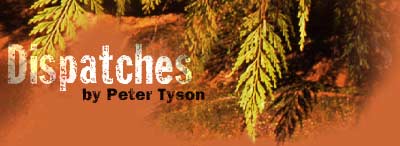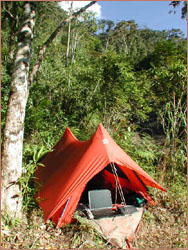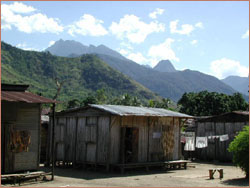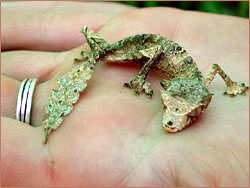 |
 
56k | ISDN Get RealPlayer software |
 May 30, 2000 Wildlife
Our tents are spread over a small ridge that leads up from a tumbling mountain brook. I call it a brook only because it has little water now in the dry season. But that water trickles down a vast slope of smooth rock slabs, enormous boulders, and cliffs that drop straight down. Clearly, in the wet season, our little creek must be a raging torrent. Unlike the English Camp at Ankarana, where trees socked us in, the slabs of rock have created an open area, affording views all around.
Wildlife abounds here. On the way to Marojejy yesterday, my guide Desiré Rabary, a robust Malagasy with a high-pitched laugh, picked out one animal after the next: a juvenile chameleon clinging to a shady weed on the trailside, a big-bodied bird with a dash of blue around the eyes (the blue coua), a caterpillar which would grow up to be ... and he rattled off the scientific name. He was just as conversant with plants. Among the many plants he pointed out were wild coffee ("just a little bit of caffeine") and a long-fronded plant locals bend in a certain way to form a cup. "When a woman is pregnant," he told me, "she places these leaves at the bottom of the rice pot so that the rice does not stick. They believe that by doing this, her baby will come out as easily as the rice."
As for lemurs, we've already seen the eastern gray bamboo lemur (a small grey-chestnut lemur) and the nocturnal lepilemur, and we've heard the woolly lemur. But as yet there is no sign of the silky sifaka. We expected this. Rabary says it can take a week to find a troop in the forest, even though curious silkies have been known to come right down to Camp Two. One must be very quiet, he says, or they flee. The porters who ferried all our gear up here on the end of bamboo poles yesterday described the lemur's cry as "she-FAHK." As Wright pointed out, that's its alarm call. Hopefully that doesn't mean they run off every time they see a person. That would not bode well for our study of this handsome primate, which Rabary assured me no less than four times during our five-hour hike up here is "the most beautiful lemur in the world." Peter Tyson is Online Producer for NOVA. We'll keep you posted on developments here at Camp Two. Dispatches Forest of Hope (June 7, 2000) A Great Day for Silkies (June 4, 2000) Camp Life Unveiled (June 3, 2000) Three Hours with the Silkies (June 1, 2000) Angels of Marojejy (May 31, 2000) Wildlife (May 30, 2000) Into the Marojejy Massif (May 28, 2000) Croc Cave (May 26, 2000) Fossa! (May 25, 2000) Bat Cave (May 24, 2000) Update: English Camp (May 23, 2000) Update: Sunken Forest (May 21, 2000) Update: Night Walk (May 20, 2000) Update: 70 Feet Up (May 19, 2000) Update: Tropical Downpour (May 18, 2000) Photos: Peter Tyson The Expedition | Surviving The Wilds | Explore Madagascar Dispatches | Classroom Resources | E-Mail | Resources Site Map | The Wilds of Madagascar Home Editor's Picks | Previous Sites | Join Us/E-mail | TV/Web Schedule About NOVA | Teachers | Site Map | Shop | Jobs | Search | To print PBS Online | NOVA Online | WGBH © | Updated November 2000 |
 The author's tent, with laptop and satellite phone ready for transmission, at
Camp Two in Marojejy Reserve.
The author's tent, with laptop and satellite phone ready for transmission, at
Camp Two in Marojejy Reserve.
 The Marojejy Reserve rises behind the village of Mandenina, which means
"waiting" in Malagasy. So much rain falls here every year, it is said, that
residents are always waiting for it to stop.
The Marojejy Reserve rises behind the village of Mandenina, which means
"waiting" in Malagasy. So much rain falls here every year, it is said, that
residents are always waiting for it to stop.
 The tiny leaf-tailed gecko brought into camp last night was no bigger than
your pinkie.
The tiny leaf-tailed gecko brought into camp last night was no bigger than
your pinkie.